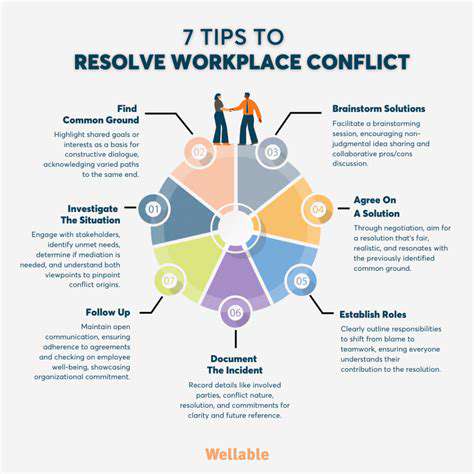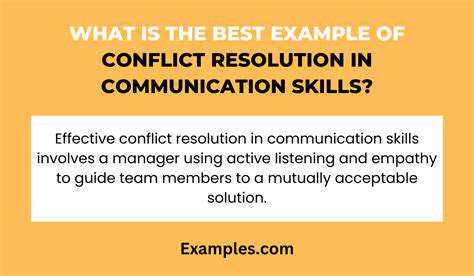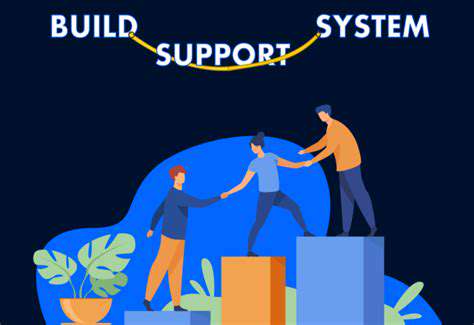Guide to Dealing with Workplace Conflict
Identifying the Root Causes of Workplace Conflict
Understanding the Different Types of Workplace Conflict
Workplace conflict isn't always about personality clashes; it can stem from a variety of sources, including differing work styles, unclear communication, and unequal workloads. Recognizing the specific type of conflict—whether it's a disagreement over project deadlines, a personality clash between colleagues, or a breakdown in communication—is crucial for effective resolution. Understanding these different types helps pinpoint the root cause and implement appropriate strategies for intervention.
Often, underlying issues like a lack of resources or inadequate training can contribute to conflict. Identifying the specific source, whether it's a systemic problem or an individual behavior, allows for a more targeted approach to resolving the conflict and preventing future occurrences.
The Role of Communication Breakdown in Conflict
Poor communication is a frequent culprit in workplace disagreements. Misunderstandings, lack of clarity in instructions, and a failure to actively listen can quickly escalate minor issues into significant conflicts. Effective communication, including clear and concise directions, active listening, and open feedback channels, is essential for fostering a positive and productive work environment.
Open dialogue and the ability to express concerns constructively are vital. When communication breaks down, it creates a breeding ground for suspicion, resentment, and ultimately, conflict.
Identifying Personality Clashes and Their Impact
Personality differences can sometimes contribute to workplace conflict. Individuals with differing communication styles, work ethics, or approaches to problem-solving may find themselves at odds. Understanding these differences and learning to appreciate diverse perspectives is key to managing conflict stemming from personality clashes. This involves recognizing that not everyone operates in the same way and learning to adapt communication styles to better understand each other.
Evaluating Unclear Job Roles and Responsibilities
Ambiguous job descriptions or unclear lines of responsibility can lead to conflict. Employees unsure of their roles or who is accountable for specific tasks may experience frustration and disagreement, especially when deadlines are looming. Clearly defined roles and responsibilities, along with well-communicated expectations, are essential for preventing this type of conflict.
Regular check-ins and clarification of tasks can help prevent misunderstandings and ensure everyone is working towards shared goals. This clarity minimizes the potential for conflict by preventing confusion and ambiguity.
Examining the Influence of Resource Constraints
Scarce resources, such as budget limitations, inadequate equipment, or limited staff, can create tension and frustration. Competition for resources can lead to conflict as employees vie for access to these limited tools. Understanding resource constraints allows managers to address the root cause of the conflict and seek solutions.
Analyzing the Effect of Workplace Politics and Power Dynamics
Workplace politics, including favoritism, cliques, and power struggles, can significantly impact interpersonal relationships and lead to conflict. Understanding the dynamics of power and influence within the workplace is crucial for addressing these issues. Promoting a culture of fairness and transparency can help alleviate the negative effects of politics and foster a more collaborative environment.
Managers must actively cultivate an environment where all employees feel valued and respected, regardless of their position or influence. This prevents workplace politics from becoming a source of conflict.
Strategies for Preventing Escalation of Workplace Disputes

Understanding the Escalation Cycle
Escalation is a process, not an event. It's crucial to understand the stages of escalation, from initial disagreement to full-blown conflict. Recognizing these stages allows for proactive intervention and de-escalation techniques. Understanding the triggers and patterns associated with escalation is vital for effective prevention. This involves recognizing individual and systemic factors that contribute to escalating situations.
Identifying the root causes of conflict and tension is essential. This might involve looking at underlying power dynamics, communication styles, or unmet needs. Understanding the context of the situation provides a framework for responding effectively and preventing further escalation.
Active Listening and Empathy
Active listening is a powerful tool for de-escalation. It involves paying close attention to the speaker's words, tone, and body language, and responding thoughtfully to their concerns. Empathy, the ability to understand and share the feelings of another, is also crucial. Actively seeking to understand the other person's perspective, even if you don't agree with it, can help diffuse tension.
By actively listening and demonstrating empathy, you create a safe space for communication and allow for the other person to feel heard and understood. This can significantly reduce the likelihood of conflict escalating.
Clear and Respectful Communication
Clear communication is paramount. Using precise and respectful language avoids misinterpretations and fosters a collaborative atmosphere. Direct and honest communication, while important, should always be delivered with respect and consideration for the other person's feelings. Avoid accusatory language or inflammatory rhetoric.
Establishing Ground Rules
Creating clear ground rules beforehand can prevent misunderstandings and conflicts from escalating. These rules should be mutually agreed upon and outline acceptable behaviors during interactions. Clearly defined boundaries and expectations can create a more predictable and less confrontational environment. Ensuring that everyone understands the rules and expectations for behavior promotes a smoother and more productive interaction.
Conflict Resolution Strategies
Having a plan in place for addressing conflicts is essential. This might involve establishing a process for mediation, negotiation, or arbitration. Having pre-established conflict resolution strategies can significantly reduce the likelihood of escalation and ensure a more positive outcome. Developing a system for addressing disagreements effectively is vital for preventing escalation.
Creating a Safe Space
A safe and supportive environment is crucial for preventing escalation. This involves creating a space where individuals feel comfortable expressing their concerns and opinions without fear of judgment or retribution. Creating a space where people feel safe and respected is essential to prevent escalation from taking place. This includes actively promoting inclusivity and respect for diverse perspectives.
Time-Out and De-escalation Techniques
Recognizing when a situation is escalating and implementing de-escalation techniques is vital. Techniques such as taking a break, using a time-out, or engaging in a calming activity can help reduce tension and allow for a more rational approach to problem-solving. Utilizing time-outs and other de-escalation techniques allows for a more controlled and productive response to volatile situations. This can help prevent a situation from spiralling out of control.
Effective Communication Techniques for Conflict Resolution

Active Listening
Active listening is more than just hearing words; it's about truly understanding the speaker's message, both verbally and nonverbally. It requires focused attention and a genuine effort to comprehend the speaker's perspective, even if you disagree with it. This involves maintaining eye contact, nodding, and offering verbal cues like I see or I understand to show you're engaged. It also means trying to put yourself in the speaker's shoes and consider their feelings and motivations, which can greatly improve the quality of communication.
By actively listening, you create a safe space for the speaker to express themselves fully. This fosters trust and rapport, leading to more productive and meaningful interactions. You'll also gain valuable insights into the speaker's thoughts and feelings, enabling you to respond more effectively and empathetically.
Clear and Concise Language
Using clear and concise language is crucial for effective communication. Avoid jargon or technical terms that the listener might not understand. Instead, opt for plain language that gets your message across directly and efficiently. This clarity helps prevent misunderstandings and ensures that your message is received as intended.
Structure your thoughts logically and present information in a step-by-step manner. This makes your communication easier to follow and understand, allowing the listener to grasp the core message quickly and effectively.
Nonverbal Communication
Nonverbal communication plays a significant role in conveying messages, often exceeding the impact of verbal communication. Your body language, facial expressions, and tone of voice all contribute to how your message is perceived. Maintaining good posture, making appropriate eye contact, and using a calm and reassuring tone can significantly enhance your message's effectiveness.
Be mindful of your body language and ensure it aligns with the message you're trying to convey. For example, crossed arms might convey defensiveness, while open posture and a warm smile can signal approachability and openness.
Empathy and Understanding
Developing empathy is a cornerstone of effective communication. It involves understanding and sharing the feelings of another person. This goes beyond simply acknowledging their perspective; it means truly trying to grasp their emotions and motivations. Demonstrating empathy shows respect and builds trust, which are essential for strong relationships and successful communication.
Listening attentively and trying to see things from the other person's viewpoint are crucial elements of empathy. By understanding the other person's feelings, you can respond more appropriately and build stronger connections.
Feedback and Active Dialogue
Giving and receiving constructive feedback is vital for continuous improvement in communication. When providing feedback, focus on specific behaviors or actions rather than making general statements. Frame your feedback in a positive and constructive manner, emphasizing areas for improvement rather than dwelling on shortcomings.
Actively seeking out feedback from others can be equally beneficial. Be open to different perspectives and use feedback to refine your communication skills over time. This process of continuous improvement will lead to more effective and satisfying interactions.
Adapting to Different Audiences
Effective communicators understand that different audiences require different approaches. Consider the knowledge level, cultural background, and expectations of your audience. Adjust your language, tone, and delivery style accordingly. Tailoring your communication to the specific needs of your audience ensures your message resonates effectively and fosters a stronger connection.
Understanding the context of the communication is also important, as this can influence the best way to approach the topic and audience. By adapting your communication style, you can create a more impactful and meaningful experience for everyone involved.




![Guide to Hydroponics at Home [Basics]](/static/images/31/2025-06/MaintainingYourHydroponicSystem.jpg)


![How to Write a Resume That Gets Noticed [2025]](/static/images/31/2025-07/BuildingaStrongOnlinePresence3AAComplementtoYourResume.jpg)



